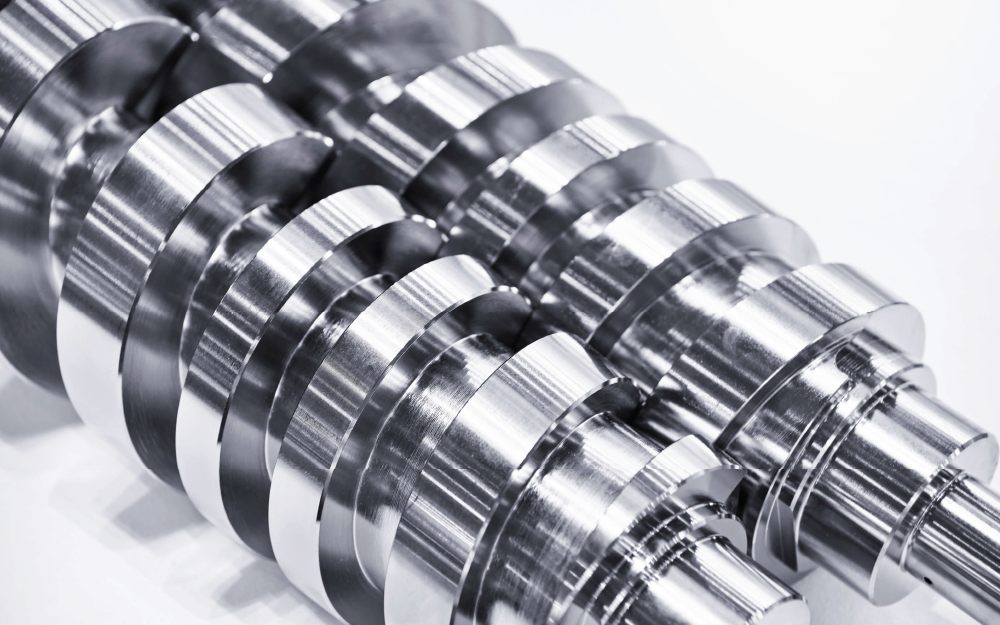What are worm screws and worm gears?
A worm gear is a staggered shaft gear (a screw) that creates motion between shafts using threads that are cut into a cylindrical bar to manage power and torque. The combination of a worm wheel and worm are the components of a worm gear. Speed reduction is determined by the number of worm threads and the number of teeth on the worm wheel. These systems are ideal where you need compact size but high ratios and high output torque, coupled with significant speed reduction
Common applications of worm screws and gears are found in the automotive industry because of their ideal use in small spaces while still outputting a high torque. An engine or electric motor provides rotational power to the worm screw so that the gear turns and pushes its force against the load.
The compact design of these gears make them a perfect addition to applications that need efficiency for specialized tasks but have limited space.
Benefits of Worm Gears
- Torque Tolerance and Durability
- Reduced Vibration and Noise
- Fast Stopping and Shock Absorption
- Reduced Friction and Roughness
- Resistance to Scuffing and MicroPitting
Types of Worm Gears
- Non-throated – Instead of a continuous thread, this style has a single moving point that contacts the gear. The minimal contact makes this type of worm drive most vulnerable to wear and tear from high unit load.
- Single-throated – This variation can withstand high unit loads with less wear. Its concave helix wraps around the worm, making continuous contact with the gear.
- Double-throated (hourglass or cone) – This style can withstand the highest unit loads without excessive wear and tear because it has concave teeth on both the worm and the gear, doubling the contact area.
Uniqueness of Finishing Process for Worm Gears
Let’s get right to the point–anything with threads requires a custom finishing process. For worm gears, the positioning and assembly of the teeth is critical since a very strict tooth design is required for the wheel gear and the worm gear to determine how the gears meet. Variations are dependent on how the gears touch.Our finishing process eliminates any imperfections found on the surface, creating a uniform finish to ensure coating materials adhere properly to the worm screws and gears. With the right preparation, our surface coatings prevent corrosion and enhance overall performance of these parts. At the end of the day, we’re working to add higher power without additional wear.
The Importance of Precisely Finishing of Gears in the Automotive Industry
The automotive industry is vulnerable to part fatigue due to cyclical stressors threatening the structural integrity of the part. Cyclical stressors can cause cracks to form, especially in areas with an abrupt surface change. Preventing part fatigue starts with achieving a superior surface finish.
Polishing the surface material eliminates stressors like sudden surface changes by creating a consistent, uniform finish. Polished parts are stronger, more resistant to corrosion, and have a longer lifespan than unfinished parts. Polishing also prepares metal parts for coatings intended to increase their durability and improve performance. We design processes for parts just like these–parts with a lot of nooks, crannys and grooves.
Performance Related to Automotive Finishing:
- Parts are Stronger and More Durable Than Before
- Increased Lifespan
- Improved Resistance to Corrosion
- Reduced Friction
- Increased Resistance to Part Fatigue, Pitting and Scuffing
- Heat Resistance/Reduction
ISO Finishing has worked with the elite in the racing industry, OEM suppliers to the automotive manufacturers and aftermarket accessory distributors. Our experience, flexibility and ability to develop the specific processes allow us to meet your finishing needs whatever they may be.
Here are some of the most common applications and their benefits that we see for worm screws and worm gears at ISO Finishing.
Automotive Steering System Efficiency
In an automotive steering system, the worm gear connects to the steering wheel through the steering column. The screw and gear work in conjunction to move the wheels in the desired angle and direction.
Vibratory polishing for worm screws and worm gears
Vibratory polishing can be a critical prefinishing process because of the physical nature of a worm screw and worm gears. The vibratory finishing process is a batch-type operation where specially shaped pellets of media and the workpieces are placed into the work chamber of a vibratory tumbler. The chamber of the vibratory tumbler and all of its contents are then vibrated. The vibratory action causes the media to rub against the worm screw and gear, which yields the desired result.
Vibratory Polishing is also used to enhance the bonding of coatings and adhesives on worm screws and gears. The lifespan of these parts are highly dependent on many different factors including:
- Corrosion resistance
- Wear resistance
- Electrical conductivity
- Electrical resistance
- Torque tolerance
Centrifugal barrel for worm screws and worm gears
Centrifugal barrel tumblers work well for jobs requiring heavy burr removal. They are also good for burnishing, rapid radiusing of edges, heavy deburring with or without media and tumbling die-castings to break the parts off the runner. They are also a good choice for very heavy loads that will not run well in a vibratory machine.


